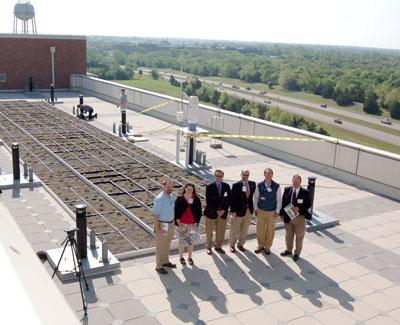Green Roof Project Open House

The University of Oklahoma National Weather center celebrated Earth Day by holding an Open House for its Green Roof Project, the state’s first experimental university vegetative roof system, recently installed at the facility. Several Conservation Commission staff attended the Open House event.
OCC’s Water Quality division is a partner in the project, working with the University of Oklahoma’s College of Architecture and its Landscape Architecture Division along with the College of Atmospheric and Geographic Sciences and the Oklahoma Water Resources Board.
Roof greening, the growth of plants on rooftops, is becoming a popular technique in North American cities to reduce stormwater runoff quantity, improve discharge quality and reduce warm-season energy demand. Recent studies show green roofs reduce annual stormwater runoff by 50-75 percent while preventing atmospheric pollutants from entering the stormwater system. Simultaneously, these vegetative roof systems intercept solar radiation and act to cool the building during summer, reducing the air conditioning costs by between 25-75 percent. The project can demonstrate broader economic benefits for the public as well. For example, covering 90 percent of the rooftops of Chicago with green roofs could save the city 750 megawatts of peak flow electric consumption annually. Rising temperatures created by the urban heat effect can be reduced by three to four degrees.
The green roof, located over the NWC’s sixth floor classroom, comprises 1,280 square feet and consists of 160 planted green roof trays. Two-foot square plant containers with four to six inches of growing media will be placed together in paddocks to create contiguous areas of green roof. Sedum plants will be used, overseeded with native grasses and perennials including blue grama and purple coneflower.
Primary investigation areas for the green roof will include plant performance, changes in the radiation balance, cooling efficiency for various climate conditions and impacts on building daylighting.
A second phase of the project is scheduled to begin later this year and will add an additional 220 square feet to the existing green roof. The roof will remain at the NWC for up to three years for investigation. Based on the research gathered, it will then be moved to a permanent location.
Despite its growth in popularity elsewhere, Green Roof is largely unknown in Oklahoma. One goal of the OCC/NWC Green Roof Project is to serve as a model and increase awareness of the concept. Its location on the University Campus will lend itself to research, examination and visitation by numerous scholars, students and officials.
The cost for the one-year project is $86,000. Funding is through the U.S Environmental Protection Agency under the Green Reserve Program. Green Reserve is a portion of the water infrastructure funds in the American Recovery and Reinvestment Act stimulus plan that is intended for communities to spend on green infrastructure, water and energy efficiency and environmental innovation. Planning and design began in July 2009 and was completed in December.
